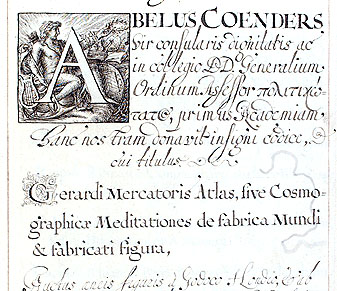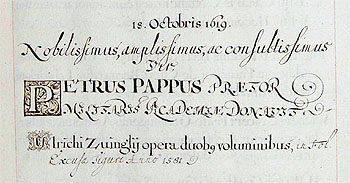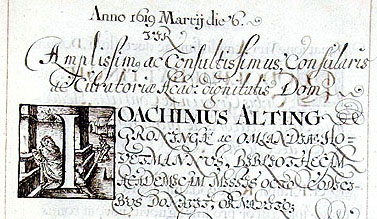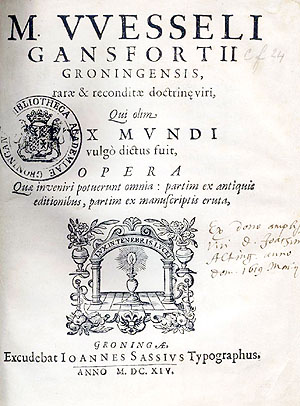|
Donations and legacies
Donations were very important for the growth of early
modern libraries, without a fixed budget, including the one in Groningen.
To thank these benefactors and to incite others to follow their example,
the names of donors were entered in the catalogues. An appropriate note
was made in the books as well. Significantly, one of the library rules of
1668 states that the professors, the librarian in particular, should do
their utmost to incite distinguished persons to provide generous
endowments. Moreover, the academy printer - a function that had been
created at the time of the founding of the library in 1615 - had to
present to the library a copy of every book he printed. Thus Hans Sas, the
first academy printer, donated a copy of Ubbo Emmius' Chronologicum
Novum in 1621.
Newly appointed professors had to present at least one book to the
library, and copies of their own publications were expected as well. They
also had to bequeath one or more books. If their personal library were to
be auctioned, the Academy Library should receive a share of the proceeds.
Donors were often eminent citizens with connections to
the new university. Undoubtedly, there have been deliberations on the
choice of books with the professors and the librarian.
The first present is dated 18 August 1615, when Abel
Coenders donated a Mercator
Atlas (Amsterdam 1606). Unfortunately, this book is no longer in
the library On 6 March 1619 Joachim
Alting presented
eight volumes, including the collected work of Wessel
Gansfort published on the occasion of the foundation of the Academy
in 1614. Also in 1619, Gansfort's editor, Petrus Pappus von Tratzberg,
presented two
volumes of Zwingli's works.
In 1620, Rudolfus Wicheringe, who had been a student of the famous Danish
astronomer Tycho Brahe, donated twenty books, among them a manuscript on
the Institutiones by Mello
Brunsema, who had taught law in Groningen from 1596 until 1601.
In that same year, Arnoldus Justus count of Bentheim presented seven
books, including a five-volume manuscript of Raynerus Pisanus' Pantheologia.
Nine volumes were donated by Edzardus Jacobus Clant, one of the Curators
of the Academy, on 22 January 1622. From the library of his wife, Susanna
van Ewsum, who died a month later, a bible in German was given to the
library. This is the only known donation from the bequest of a woman.
|
|




